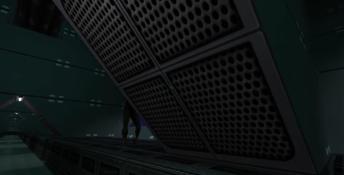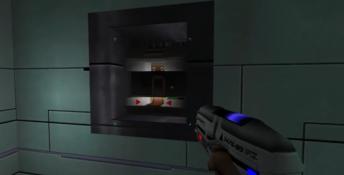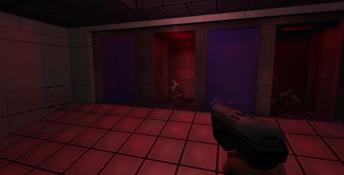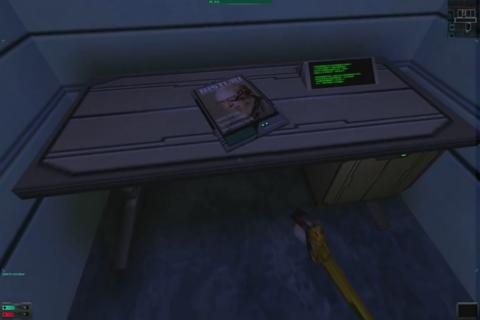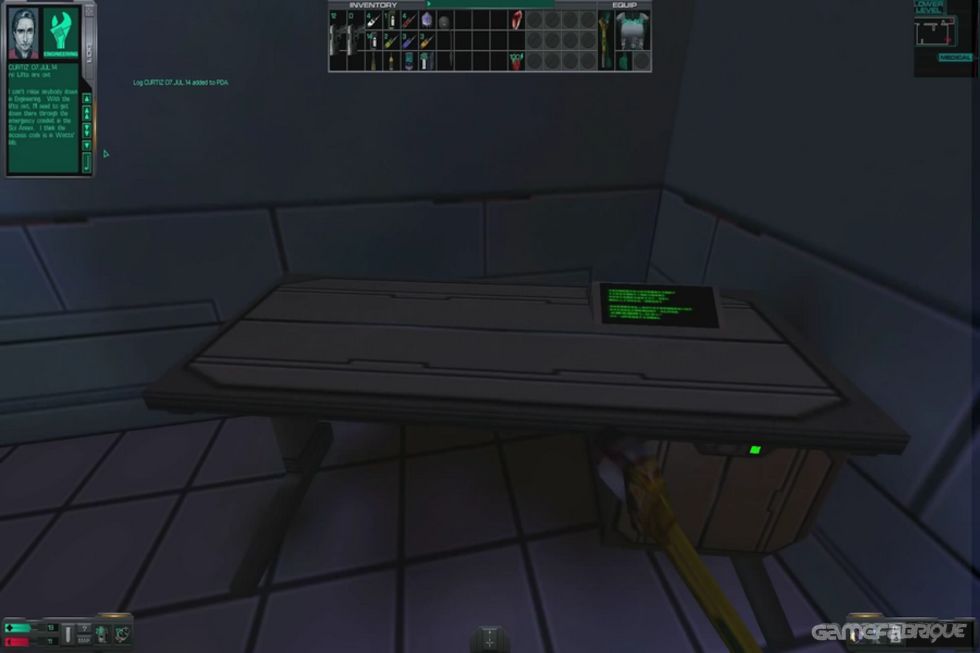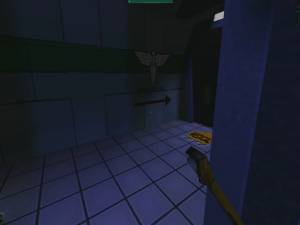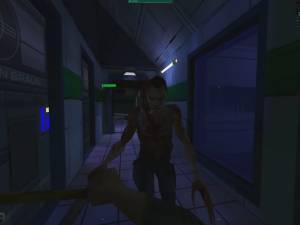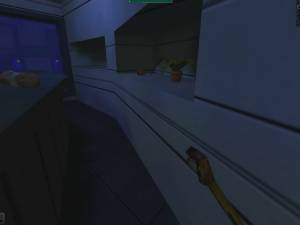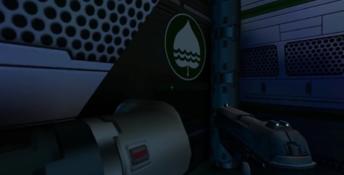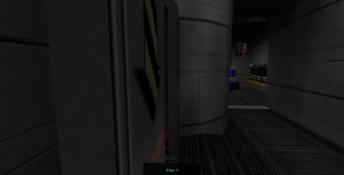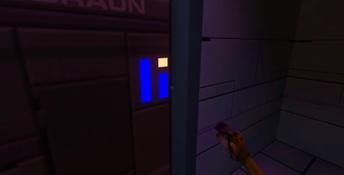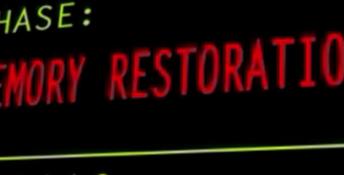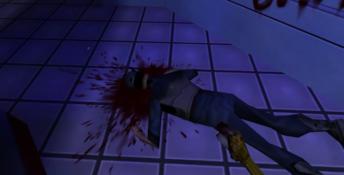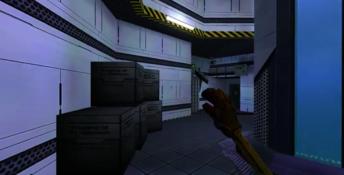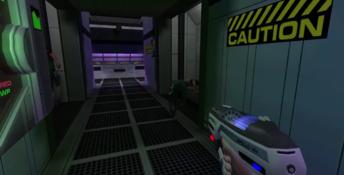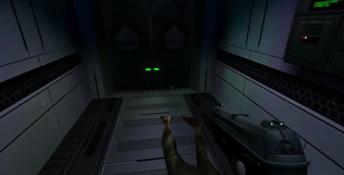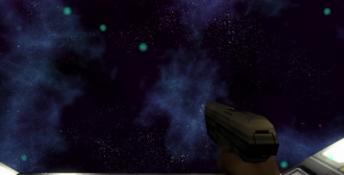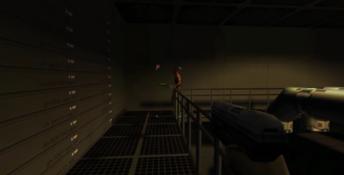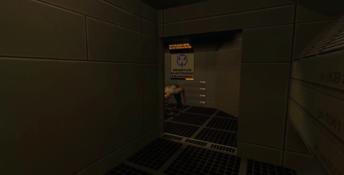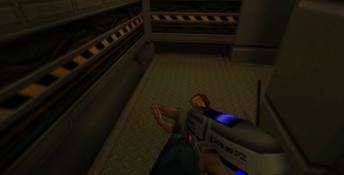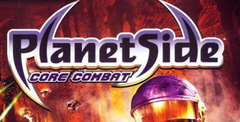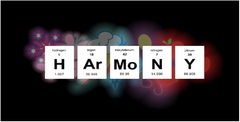System Shock 2

| a game by | Electronic Arts |
| Platforms: | Dreamcast, PC |
| Editor Rating: | 6/10, based on 2 reviews, 8 reviews are shown |
| User Rating: | 8.4/10 - 5 votes |
| Rate this game: | |
| See also: | First Person Shooter Games, Sci-Fi RPG, Retro Games, Games Like Spider-Man Remastered, Games Like Cyberpunk 2077, Games Like Bioshock, Games Like Bioshock Infinite, System Shock Series |
Players Guide: Part 1
There's no doubt in our minds that System Shock 2 is one of the greatest games ever - it's certainly one of the most atmospheric and downright scary. In fact, you're likely to become so immersed in it, you won't be able to stop until you've completed it. To avoid any unnecessary frustrations, here is the first part of our thorough guide to getting to the end. Keep in mind that you create your own character and develop him as you progress through the game. Choose your skills wisely and read on.
MED/SCI
As you wake up you receive an email from Dr Janice Polito. The message explains your partial amnesia, warns you that something has gone drastically wrong with the ship and instructs you to meet her on the operations deck (deck 4). The elevators have no power; in order to restore it, go to the engineering deck through the maintenance access shaft. The shaft is locked, so get the code from Dr Watts in the crew sector. The crew sector is also locked, but you can get an access card from Grassi in the medical sector. Unfortunately, the door to the medical sector has lost power as well, but it can be reopened with a power cell. There's one by the door, but it's not charged, so you have to find a recharger.
Just down the hall from the door to the medical sector you find a room with a quantum bio-reconstruction machine. Once this machine is activated, your body is automatically reconstructed inside the machine whenever you 'die'. The machines have a limited range, so try to find and activate them whenever you enter a new sub-level.
You can find a recharger under the pump station, but watch out for the nearby turrets. Recharge the power cell and proceed to the medical sector. Grassi is in the lower level of the biopsy lab in this sector. Get his access card, go to the crew sector and find Dr Watts' quarters (they're clearly labelled). He's not there, but he has left a spare access card to the R&D sector in his desk, so try his office there. You find him when you get there, and he gives you the code to the maintenance access shaft.
Engineering
To restore main power and get the elevators working you need to get into the engine core. However, the seals on the core have been automatically locked due to a radiation leak in the coolant tunnels. The leaks are pretty bad, so you need plenty of anti-radiation hypos while travelling through this area. You could purge the radiation from engineering control, but Sanger has recoded the door lock. Sanger is hiding in cargo bay 2, which is also locked. You can find the access card for cargo bay 2 in cargo bay 1 (though you might want to stop in at command control first, where there's a quantum bioreconstruction machine). Sanger is in cargo bay 2B, all the way back, on the top level; you can get the code to engineering control from her.
When you get there you find that Xerxes has locked out the controls. Luckily, a log left here by Delacroix tells you how to perform a manual override. First, you need to get part 45m/dEx from a storage room in the coolant tunnels.
Bring this part to the command control centre at the far end of engineering and install it in the system's monitoring unit. Return to engineering control and purge the radiation.
You are now able to enter the engine core and restore main power. You need to reset both nacelles on the lower level of the engine core, then reset the master power computer on the upper level. Once power is restored, you can (optionally) use a lift from the engine core down to a tunnel in the lower level of engineering. This is a shorter route back to the elevator than going through the coolant tunnels, but there are a lot of monsters down there, so you might prefer to take the long way around.
Hydroponics
When you try to take the elevator to the ops deck you find that the elevator can't get higher than the hydroponics deck. The aliens are using the hydroponics deck as a breeding chamber, and some of their biomatter is clogging the elevator shaft. To clear the biomatter you need to find (and research) an experimental substance called Toxin-A, and place some of it in each of the four environmental regulators on this deck. There are five vials of Toxin-A (though you only need four of them): one is in the administrative offices of sector C, two are inside a locked office (you need to break a window to get in) in the biological survey area of sector C, one is in the chemical storeroom in sector B, and the last one is on a corpse just inside sector A. If you don't want to buy the research skill, you can research the Toxin-A with the help of a lab assistant implant, although even with this you still need two units of antimony and one of vanadium; these can be found in the chemical storeroom in sector B, or by going back to the chemical storeroom on the engineering deck.
There is one environmental regulator in each of the four sectors, marked on your automap with an'A'. The elevator lets you out into sector C, but the other sectors are all locked.
You can get into sector B by breaking some windows that overlook it, either near the administrative offices or near the experimental office. A body in the biological survey labs has the access card for sector B, so you can get in and out without having to jump through windows. Another body in sector B maintenance has the access card for sector A. Once you're in sector A, you need to find the access card for sector D, which is on a body near an assault rifle.
Place Toxin-A in each of the environmental regulators.
Operations
Your first task is to go to Dr Polito's office in sector A. Turn right out of the elevator, and go through the bulkhead on your right. She explains how a bizarre hive-mind (called 'The Many') evolved from the mutants SHODAN created back on Citadel Station. The Many have taken over some of the crew members of the Von Braun with their telepathic powers. Worse still, SHODAN herself has gained a foothold in the computer system. However, she and The Many seem to be working at crosspurposes, and The Many is the more immediate threat. After this meeting you need to perform tasks on both the operations and recreation decks. You can go on to recreation now and go back to the tasks on this deck afterwards if you prefer.
The three simulation units on this deck have been co-opted by The Many to engineer a mutagen which will create a new kind of hunter-killer hybrid - you have to reprogram all three sim units to prevent this from happening. In order to do so you need to get three special chips (one for each sim unit) that are being carried by special red cyborg assassins.
These are tougher than the ordinary cyborg assassins (who are no pushovers!), and are programmed to try and avoid you whenever possible. Watch which way they run, track them down to their hiding places, and kill them. There is one red cyborg assassin in sector B (hiding in the systems administration area), one in sector C (hiding in the storage area), and one in sector D (hiding in the command centre, not far from the brig). Take the chips from their bodies and place each one in the matching sim unit to reprogram them. One sim unit is in sector C in the power administration offices, one is in sector D in a security station near the brig, and the other in the lower level of power operations.
Recreation
Some crew members on the recreation deck were building a transmitter to warn Earth. They were unable to complete the job, so you must find and activate the transmitter. The activation code is hidden in art terminals scattered around this deck, so cycle through all available pictures at each art terminal to find pieces of the code. The locations are: sector A (across the hall from the upgrade units and upstairs in the crew sector); sector B (in the pool hall) and sector C (in the ArTechnology store in the mall). The transmitter is in the athletics sector, which is locked. The access card for it is in the crew sector, which is also locked, so find the access card for the crew sector in the maintenance tunnels under the garden in sector B.
Download System Shock 2

System requirements:
- PC compatible
- Operating systems: Windows 10/Windows 8/Windows 7/2000/Vista/WinXP

System requirements:
- PC compatible
- Operating systems: Windows 10/Windows 8/Windows 7/2000/Vista/WinXP
Game Reviews
What we thought
"It's a game you will complete, then play through again: it's nothing short of a classic of its time. Go out and buy it now."
What you think
People say:
- "Your claim that System Shock 2 may be the best RPG ever could well be true. The original System Shock was a classic game and the graphics and atmosphere in System Shock 2 make Half-Life look dated." "Amazing graphics, incredible storyline, unbelievable sound and one of the best control systems around make this the game of the year, without question. And it'll scare you senseless too. Forget Quake II, Quake III or Half-Life, this is the new benchmark. Did I say it was good? Well it bloody well is! Deserves more than 95 per cent methinks." "I wouldn't have given this game 80%. Hacking a security device didn't feel at all satisfying. The security cameras are a good addition, but at no point did you feel you had to look out for them. The combat is slow and boring. Most of the weapons are poor. Whoever said it was hugely atmospheric obviously hasn't bothered to play Thief, because the atmosphere in that game was much greater than this pile of steaming poo." "Just as your review states, a brilliant, truly immersive game. "It's a game you will complete, then I would class It as a first-person action adventure, as the only RPG element Is the skill system which doesn't grow with experience but with the nodules you find. Also, there aren't any characters to interact with, the most important element of a RPG in the classic sense.'' "This game is simply stunning. Amazing graphics, sound and atmosphere, but for once the real plus is the gameplay. Simple to start playing. Difficult to stop. It's a joy to play from beginning to end. The multiplayer aspect is fantastic and it's nice to see that the developers stuck to their guns and went for the co-op version and not some pissy deathmatch. In short, why are you reading this when you could be playing the game?" "This game is everything a gamer wants - it's a classic. There's so much you can do, and you can be what you want to be. The sound and the setting gives the game that eerie feeling that games like Quake just don't have. The dead bodies, the alien taunts, the dark corridors, the exploding computers all make me take every step with caution. If you want a game with action, brains and scenes that fill your pants, buy this one."
Player's Guide: Part - 2
The second part of our System Shock 2 guide proves just how good a game it is. The variation in the levels is truly outstanding, and the plot unfurls in a dramatic manner. And, just when you thought it was all going to come to an end, the story branches out in another direction and you get a new weapon to play with...
Command
The Many has infested so much of the Von Braun that it seems like a good idea to scuttle her and escape aboard the Rickenbacker. It's going to take some high level access to do that, however. You'll need to use a restricted computer on the Operations Deck to open a data channel to the Rickenbacker, and then go to the Engineering Deck and set up the engines for a remotely activated self-destruct. Your associates can get the self-destruct code for you, but you'll need to retrieve the Ops Override access card yourself.
The Ops Override Card is kept on the Bridge, which is locked, so you'll need to search for the Bridge access card. It can be found near one of the Escape Pods (apparently some crew member dropped it in their rush to escape). You might find it convenient to pick up the Shuttle access card at this time, since you'll need it later. The Shuttle access card is in a locked Security Station in the Officer's Quarters. If you search the lockers in the nearby rooms, you'll find a log that has the code to the Security Station. The Ops Override card can be found on the upper level of the Bridge, in a small niche behind some glass. This is an emergency, so go ahead and break that glass.
Return to the Operations Deck, and go to the Command Centre in Sector D. The Ops Override card gives access to a terminal from where you can open the data channel to the Rickenbacker. Then go back to Engineering and head to Core Control to arm the self-destruct mechanism. Finally, return to Command.
When you arrive back on Command, you'll find that The Many has placed a number of its Eggs on board the Command Shuttles, in an attempt to escape the coming destruction of the Von Braun. In order to avoid having to do this all over again later, destroy the shuttles before they escape. They are protected by shield generators, which can be turned off from the Shuttle Control area, above the Shuttle Bays. One of the shuttles proves to be straightforward to deal with, just bring down the shield, then destroy the shuttle with whatever weaponry comes to hand. The Many realises what you are doing however, and sabotages the control computer for the other shield generator, making it impossible to turn off the shield. The shield generator can be destroyed by attaching a Sympathetic Resonator to it.
To get a Sympathetic Resonator, you'll need to hack the replicator just outside Shuttle Control (an associate of yours uploads the design into the replicator remotely). This is an easy hack, but if you have no hack skill whatsoever, you'll either need to acquire that skill, or find an ICE-Pick.
When the shuttles are destroyed, you'll escape to the Rickenbacker, but find your way blocked by a psionic barrier. You'll get an email message from Anatoly Korenchkin (who has been mutated by The Many into a Psi Reaver) telling you to meet him on the Bridge. In order to bring down the psionic barrier, you'll have to kill Korenchkin. Psi Reavers are extremely hard to destroy... until you know their weakness (not that they are all that easy even then). Make sure you've found and read the log from Prefontaine that discusses "Floating psi-users" before going to this fight. After defeating him, proceed through the grav shaft to the Rickenbacker.
Rickenbacker
The Rickenbacker has been infested with a new form of Annelid Egg. While they are no immediate threat to you, if allowed to mature they will hatch a new generation of monsters that you would have no hope of defeating. Hence, you must destroy all 16 Eggs before you can escape. They're quite visually distinctive and emit a slight buzzing sound, so you should find them all easily rf you stay alert. All of them are somewhere in Pod 1.
The Rickenbacker has taken some serious damage due to sabotage. You'll see a massive hull breach that's covered only by a force field. A room on the other side of the hull breach contains an access card that you'll need to get through the Rickenbacker, so you'll have to get over there. You can extend some support struts to partially cross the hull breach, but eventually you're going to have to make a careful jump to get there, and another one to get back (remember: the better your agility, the faster you'll run and the further you'll jump). In order to avoid triggering another hull breach in Pod 2, you'll have to reverse its artificial gravity before entering it. To do this, you must find the control computer for the gravitonic generators inside Nacelle B.
Eventually, you will find a large room with two torpedoes along each wall and a control station in the centre. The buttons on the control station raise and lower the torpedoes. The ladder to Pod 2 was in this room, but has been broken off at the bottom. In order to get to the intact part of the ladder, you'll have to use the torpedoes in a fairly complex way. Note: if you haven't received an email message confirming that there is only one Egg left to destroy, you should go back and look for the ones you missed before going on through this puzzle.
While facing the control panel, raise the two torpedoes on your left as high as they will go, and also raise the rear torpedo on your right. Turn right, and step onto the torpedo that you left in the lowered position. There is a ledge behind it that you can mantle on to. Move right along the ledge, and near the back of the room you will see a raised platform crossing to the other side. Jump to that platform and cross the room. On the other side of the room, step onto the raised torpedoes. Run along the length of the torpedoes, and jump onto the ladder at the Make your own platform far end. From here, you can continue climbing.
As you continue through the Rickenbacker, you'll come to a corridor filled with very high radiation levels. While it is theoretically possible to get through the radiation and live (if you have good enough stats and equipment), there's a simple way to clear the radiation from the corridor. The radiation is leaking out of a torpedo cluster adjacent to the corridor. Nearby, you'll find a control room with a button that will let you launch that torpedo into space. Once the torpedo is gone, the radiation will also be gone.
When you reach the elevator up to Pod 2, you should find the final Egg beside it. You may now pass through the upside-down Pod 2 and proceed to the Bridge of the Rickenbacker.
Unfortunately, when you get there, you discover that the biomass of The Many is now completely wrapped around the outside of the ship, preventing you from separating from the Von Braun. In order to have any hope of escape, you'll have to try to destroy The Many once and for all... from the inside. Use a Rickenbacker Escape Pod to launch yourself into the belly of the beast.
Before you do this, you may want to accumulate as much weaponry and ammunition as you can (not forgetting to check out Diego's quarters for strange alien weaponry) because once you enter The Many, there's no going back...
The Many
Once inside The Many, you'll need to get through a tew closed Sphincters (equivalent to locked doors). The Sphincters are controlled by Nerve Clusters. To open them, destroy all the Nerve Clusters you can find.
Your progress will also occasionally be blocked by translucent membranes, but these can be easily tom apart with almost any weapon. After getting through the first Sphincter (you'll need to destroy two Nerve Clusters), you'll find yourself in the digestive tract of The Many. You'll encounter huge moving 'teeth' that grind up food once it's been ingested.
As the teeth move up and down, you can jump on and off them but be careful not to get ground between them! By riding the teeth, you can reach the last Nerve Cluster, and once it's destroyed, you can get through the last Sphincter. This leads into the area where new Annelid Eggs are created.
The exit from this area is a very high jump into a deep pool of water (Scary! - Ed). When you climb out of this pool, there's only one way to go, which leads directly to the chamber holding the Brain of the Many. This chamber is well guarded and you can'tkill all the guards, as more will keep coming. You can reduce the monster population somewhat by destroying all six Psi Reaver brain structures, but do not kill the Cyborg Midwives. Killing them will trigger immediate reinforcements. You'll notice that there are three small spiky objects travelling in irregular orbits around the Brain.
When you try to shoot the Brain, these objects will light up, and the Brain will not take damage. You must take out these 'defence nodes' before you can damage the Brain itself. Once all the defence nodes have been destroyed, the Brain itself should be relatively easy to kill, as long as you can survive the attacks from the guardian creatures. Killing the Brain reveals a passage below where it was. Enter this passage to proceed to the final level.
There are no entirely new enemies inside The Many, but this is the first place you'll find large numbers of Psi Reavers.
Shodan
In the final stage of the game, you will discover SHODAN's true plans. Read all the logs from Dr Delacroix to get a full understanding of the task ahead of you. When you find the SHODAN Core, you'll find it guarded by a SHODAN Avatar which will attack you. Don't bother trying to kill it, SHODAN will just recreate it again. The SHODAN Core is also protected by rotating force fields. If you are a hacker, you can bring down the shields by hacking into all three nearby computer terminals (hacking just one or two does nothing). Be careful, though, as the floor around these computers is intermittently electrified. If you're unable to hack these computers, you'll have to bring the shields down with brute firepower. Each shield regenerates strength over time (unless completely destroyed), so use the fastest firing mode of your weapons. Once the shields are down, take out the SHODAN Core as fast as you can.
With SHODAN and The Many both defeated, you can finally return home with the few other survivors and retire in safety... until System Shock 3, that is!
What we thought
"System Shock 2 is almost certainty one of the deepest and most enjoyable role-playing games we've ever played, requiring focus, skill and determination."
What you think
People say:
- "System Shock 2 is the most amazing game I have ever played. "It might be a little bit overwhelming at first, but once you get into it, it's brilliant I think you underrated it - it should have got 98%."
- "I've just completed System Shock 2 anti it's the best singleplayer game I've played in ages. Everything about it generates terror and tension and there's a frightening lack of firepower at the start. This is one game where you can't charge through with guns blazing - every bullet is sacred."
- "This game is amazing. The graphics are much better than Half-Life, and the RPG elements add to it amazingly. The hacking elements are brilliant and the character-building mode is great. The best game for a long, long time."
- "Forget Tiberian Sun and Hidden and Dangerous, System Shock 2 is the game of the year. It has everything - atmosphere, storyline, gameplay and graphics. didn't sleep for three days and now I'm playing through again. If the polygon characters were better it would have been perfect."
- "What can I say? I live in awe of the greatest game ever - it's even scarier than Alien Vs Predator. If you have the right PC specification - buy it now! If you haven't - upgrade!"
First released in 1994, the original System Shock is still considered by many to be a classic of its type. Using advanced 3D technology carried over from developer Looking Glass Studios' successful Ultima Underworld series of games, System Shock mixed hard-core role-playing, serious sci-fi and the best 3D graphics money could buy to great effect. It had depth, a strong storyline, hacking, technology, puzzles, weapons and... ohmygod, 'those' graphics.
Five years on, it seems things are about to come full circle. Having achieved considerable success with Thief: The Dark Project, Looking Glass are using the same engine to power System Shock 2. The game will combine hard-core role-playing, serious sci-fi and the best 3D graphics money can buy to great effect - again - only this time in a richer, more detailed fashion than most role-playing gamers are currently accustomed to.
In the past, RPG fans have had to put up with an array of banal fantasy titles with less-than-convincing visuals (Lands Of Lore III and Return To Krondor spring to mind). But not any longer, it seems. System Shock 2 utilises Looking Glass' tried-and-tested Dark engine, albeit vastly enhanced, and the results are already looking very impressive indeed. So hard-core RPG fans will no longer have to endure crap graphics.
Another Dimension
We recently got the chance to talk to Ken Levine, lead designer on System Shock 2. We asked him why he thought so many previous RPGs had managed to get away with such appalling graphics. "The 'harder-core' a game appears to be," explains Ken, "the more people feel they can let graphics slip. We see no reason why a role-playing game can't be technologically competitive. Because we've got a strong engine and a great graphics team, we didn't really feel we had to let the art slip."
So System Shock 2 is as 'hard-core' as they come, then?
"Yes, very much so," says Ken. "What System Shock 2 is doing is bringing the hard-core RPG to a level of technology that most RPGs don't have. The Might & Magics and Fallouts of this world look good, but they're not up to the quality of System Shock 2."
And Ken is right - we've borne witness to that with our own eyes. System Shock 2 is not far from completion, as the beta version we have in our very hands so effectively demonstrates. Graphically, the RPG is about to enter another dimension...
IN-GAME CHARACTER GENERATION
But it's not just the graphics that set System Shock 2 apart from its competitors. It's also the detail in the design that makes it such a hot prospect for those of us bored by the relentless deluge of 3D action games. System Shock 2 is not just a first-person shoot 'em up, as Ken explains.
"In System Shock 1, you could turn the combat up or down, or switch the puzzle aspects on or off at the start of the game. We've expanded that. You have to approach the situations in the game differently, depending on the character you are. If you're playing a weapons-oriented character, you tend to approach problems with all guns blazing; if you want to play a more technical role, you could avoid combat and hack your way through a situation. If you're very good technically, you can modify items to make them more useful, and so on. Every character has its own strengths and weaknesses." In System Shock 2, it will be up to you to control how your character develops and the skills they acquire as the story unfolds.
How you create that initial character, incidentally, is one of the game's most original features. Starting off four years before the game begins proper, System Shock 2 features 'in-game character generation', which basically means that you get to go through a series of training missions within the context of the game itself, rather than selecting how much facial hair you want from a pre-defined selection of portraits. You start off wandering the city streets, end up inside a military recruitment office with a choice of careers. Joining the Marines puts you through an intensive course in weapons training, while plumbing for the Navy results in heavy-duty technical schooling. If you're the kind of person who likes to dabble with 'magic' in these kinds of games, then joining the OSA (secret service) will be the right career choice, as the OSA specialise in the use of psionic (mind-based) abilities - as seen in Stephen King's Carrie.
Each of the three disciplines has its own set of training criteria and, once completed, furnishes your character with a full complement of special abilities and fully prepares them for the (monumentally) huge task ahead.
Serious Sci-Fi
In terms of gameplay, the idea behind System Shock 2 is fundamentally the same as in the first game. You're cybemetically enhanced soldier of the future, trapped inside a vast, deep space-bound vessel overrun by a powerful central computer system with deadly delusions grandeur. It's an idea that harks back to 1968 and Stanley Kubrick's classic 2001: A Space Odyssey - the story of a powerful computer gone haywire -although Levine cites other influences as being more significant.
"We were very influenced by an old paper game called Traveller. It was serious sci-fi - not fantasy sci-fi - and we embraced the technological aspects of this scenario wholeheartedly. That's what we wanted to do with System Shock 2. Of course, there are references to movies, but then most science fiction games have that sort of thing." The mysterious SHODAN - a female version of 2001's HAL 9000, and the main protagonist in the original System Shock - makes a return in System Shock 2, although her presence is initially not your main concern. "Not only are you up against the forces of SHODAN, but another enemy has come into the picture - a collective called The Many," explains Ken.
Like the Borg from Star Trek? "No, they are strictly organic. These wormlike creatures use humans as hosts, turning them into hybrid zombies. Over time, they can morph into a number of different states, some of which are truly disgusting."
Was Ken going for big scares in System Shock 2? "Oh yes." And gore? "Well, you certainly need a sense of Grand Guignol in these things, but we're going at it in a fairly restricted manner. We're going more for a feeling of suspense and terror than actual gross-out gore horror."
Level Of Detail
There are currently 25 people working on System Shock 2, which is not surprising when you have a look 'under the bonnet'. The game is already packed with detail - hacking (of course), weapons modification, maintenance, research, reams of statistics... tons of stuff - even though there's still more to go in.
As in any good RPG, System Shock 2 will inundate you with useful items and objects, and half the fun will be working out what goes where and what can be done to what to increase your chances of survival. As any RPG fan knows, the developers will have to spend time making sure the interface is unobtrusive for this kind of approach to work properly and -happily - we can report that System Shock 2 already feels more than well catered for in this particular area.
Rather than have you leave the action to check your stats or inventory, Ken and his team have gone for the 'head up display approach with regard to the presentation of information, with pop-up windows overlaying the main view area while you continue to move around freely. This means you can organise your inventory while on _ the run from particularly scary monsters, which is very handy. Delving into these menus reveals a wealth of information - such as stats, tech skills, combat skills, psionic abilities, maps, research updates, logs, notes and emails - so you may be forced occasionally to find a quiet corner and pore over them.
The Nature Of Role-Playing
This detail also extends into the game's weapons system. Looking Glass claim that System Shock 2 will have "the most detailed weapons simulation in any first-person game". We asked Ken Levine how much more sophisticated these weapons systems could get. "We have 14 different weapons. Each of them has two different settings - except for the wrench, which is simply used to hit people over the head - and between two and five different types of ammunition, all of which are effective against different targets. Armour piercing is more effective against robots, EMP rounds are only effective against robots and not at all effective against organic targets."
Playing the beta version of System Shock 2 confirms this - you really have to think about what you're aiming at before opening up. And it does seem to add a whopping great dollop of tension to the atmosphere.
"Also," continues Levine, "each weapon has a modify path and you can upgrade them over time. For instance, you can modify the assault rifle to hold more rounds of ammunition, or fire at a faster rate, or do more damage. It's a technical skill you acquire in the game." This procedure is not without its risks, though. "If you fail critically, you'll break that weapon," says Ken matter-of-factly.
Balancing technical skills I will play a significant part in the proceedings, and the process of upgrading and refining them is not only fairly logical, it also contributes greatly to the game's role-playing sensibilities. Being a living cybernetic human, you have a hole in the side of your head that you can plug stuff into. And plug stuff into it you do -particularly hardware upgrades that enable you to hack or research things. Once this hardware is in place, your skills can be developed by trading 'cyber upgrade units' (That's experience points to you and me - Ed) in return for a boost. So as you get better at the game, you get better at performing particular tasks, and the make-up of your character is formed as a result. But these cyber upgrade units will be quite hard to come by and some soul-searching may be needed before 'spending' them. Such is the nature of the role-playing game.
Don't Do Deathmatch
One original feature of System Shock 2, unheard of in a role-playing game until now, will be in the use of its multiplayer facilities. Rather than tack on a few deathmatch levels at the end of development, the designers decided a multiplayer co-op version of the single-player game would be more interesting. So that's what they set to work on.
"There are a lot of games that do deathmatch extremely well," reasons Ken, "and if you wanna play deathmatch then those are the right games to play. What we want to do with System Shock 2 is expand and adapt the single-player experience to a multiplayer environment. We're supporting four-person multiplayer team play, which takes you through a modified version of the single-player storyline. This way you can really develop a party of differently styled characters and let them support each other's skills."
It's an idea that has been bandied around by a number of developers recently - playing your way through a singleplayer game with a party of human cohorts - and Looking Glass could be the first to get it right. How the logistics of putting together a multiplayer experience of this kind are handled, we don't know. 'The game will be rebalanced to incorporate more people, obviously," says Ken. Hopefully they'll get it right.
General Vibe
From what we've seen so far, Ken Levine and his team seem to be getting pretty much everything else right. There was something about the original System Shock - the fact that although it was quite obviously all a work of fantasy, you were drawn into this pseudo-realistic high-tech world of gadgets and computers, and bought the lot of it. It felt intense and realistic, even though the game dealt with the kind of subject matter 2000AD would have been proud of.
"The general vibe of the game is one of realism," Ken explains. "This is - ough situation you're in you see the movie Alien? the kind of feeling we've tried to capture in System Shock 2."
The same eerie silence that permeated Alien, as well as the classic horror adventure Resident Evil 2, also casts a shroud of dread over System Shock 2, and this mixture of realism and atmosphere should certainly conspire to give us all heart attacks. Luckily, as with Thief: Dark Project, you can lean around comers to see what's out there, and hear monsters scratching away in the distance before they get to you. However, neither of those abilities are any guarantee that you'll make it out of System Shock 2 alive.
That's Irrational, Cap'n
Irrational Games are working on System Shock 2 tor Looking Glass Studios with Electronic Arts as publisher. Confused yet?
Irrational Games were founded in May 1997 by three former Looking Glass employees - Ken Levine, Rob Fermier and Jon Chey - who between them had worked on the original System Shock, Thief and a number of other in-house projects. For their first outing, Irrational were approached by Looking Glass with a view to producing a game using their proprietary 3D engine.
"The reason I came back to Looking Glass," says Ken Levine, lead designer on System Shock 2, "was because I loved System Shock so much. Looking Glass came to us and said: 'How would you like to work on a game for us using the Thief engine?' And the first thing we said was: 'Why not try and do System Shock 2?"
Looking Glass agreed and the project was green-lighted. Irrational then took up residence In a comer of Looking Glass' Cambridge, Massachusetts, office -effectively returning to their previous place of employment to work on their first game. Says Ken: "The idea to do a sequel had been around for such a long time that it seemed crazy not to do it now."
Imagine a world in which Deus Ex, Morrowind, Knights of the Old Republic and Vampire: The Masquerade - Bloodlines never existed. It's a scenario that's not as far-fetched as you may thipk. Had it not been for 1999 ground-breaking System Shock2-agame that helped reinvent the RPG genre and led it confidently down the revolutionary first-person perspective path first pioneered by Ultima Underworld and later by System Shock - then perhaps we'd never have had a chance to experience these more recent RPG gems.
System Shock 2 was a revelation, its perfectly-crafted plot submerging you into a dark and sinister science-fiction world in which you had to uncover the truth behind the mass murderof your ship's crew members - and your true identity. From the breadth of its character creation options and the unique way in which your abilities shaped how you played the game, to its deeply compelling, mature and intelligently crafted plot that explored the struggle between humanity and machines. System Shock 2's influence still resonates like a crashingbell throughout the entire genre.
It was also the game that was to forge the foundation for irrational Games to build upon, a titanic debut title thatk jfculd not only enable the developer to blossom into one of the most sought after games development teams in the world, but also stamp its influence op RPG gaming history forever. Having cut their teeth on Thief: The Dark Project at legendary games development house Looking Glass Studios, Ken Levine and Jonathan Chey formed Irrational Games in 1998. The pair then quickly set about collaborating with their previous employer on an all new project.
When we started Irrational. Paul Neurath of Looking Glass, who we knew from working there, came to us and said, so, wetve got this Thief engine which you guys have worked on. We'd like to use it for another game. Have you guys got any ideas'? recalls Ken. We all shouted, System Shock 2! System Shock 2!', and Paul said, 'That's great, but we don't have the rights.' Undeterred, we then said, OK, something similar to System Shock 2'. And so work began on a game called Shock (see what they did there?), and several months later Irrational was presenting a prototype to the bigwigs at EA, which, through a twist of fate, owned the rights to System Shock. Can you guess what happened next?
Weight Of Expectation
Being handed the System Shock licence on an EA-branded platter brought with it not only a unique opportunity for the newly-formed Irrational team to make a name for itself, but also crushing pressure to create a game worthy of its legendary predecessor. This is something the two men were acutely aware of as they set about their task. But as Ken explains, System Shock's legacy also brought with it its own inimitable benefits. System Shock really set the tone for System Shock 2. It allowed us to treat the subject matter much more seriously than a space opera or a zombie frag-fest. It expanded on what Ultima Underworld did in terms of emergence and even physical simulation, explains Ken.
As well as that, it established a structure for knitting together first-person shooters and role-playing games, adds Jonathan. I think System Shock really established the notion of immersion in a stronger way than it had ever been done before, with the player being an actual entity in a simulated universe. And so development on System Shock 2 began in earnest, with Irrational's small team throwing itself into the project with unwavering commitment and a lucid idea of the direction in which it wanted to take the game.
System Shock 2 never really changed much from the original conception, remembers Ken. To be honest, the Thief engine wasn't exactly a visual powerhouse. Knowing that we couldn't compete graphically with the Quakes and the Unreals of the world, we decided to focus on gameplay, specifically on story and RPG elements. From the first prototype, we had the whole notion of a Shoot Mode and an Interact Mode in the interface. It got tweaked a bunch, but that was always there. The first prototype played very much like the final game, but in a far cruder form. But just like any ambitious project, System Shock 2's development was not bereft of problems, both technical and personal, the latter causing several heated arguments between some of Irrational's most senior members. Me and a guy called Rob Fermier had huge fights about the whole notion of the player being tricked early on by SHODAN," recalls Ken of his arguments about one of the game's pivotal characters.
In the game, you're led to believe that you're being guided by someone named Polito, who is actually SHODAN in disguise. I wanted to mess with the player's trust for the information the game was giving them, and Rob thought that would alienate the gamer. I think I was right on that one.
However, Ken is man enough to accept that he wasn't always right. The much maligned weapon degeneration system, which would see your gun jamming at the most inappropriate moments due to cumulative wear and tear, was actually Ken's idea. It's also one of his biggest regrets. I didn't get death threats over that feature, but you wouldn't want your mother reading some of what's been posted about it, he admits.
Holes In The Code
Irrational's already gargantuan goal of creating a revolutionary game was made even harder thanks to the team having to work with an unfinished version of the Dark Engine throughout most of the project. With only months to spare before System Shock 2 was to ship, the finished version of the Dark Engine finally arrived from Looking Glass Studios, forcing Irrational to work in sweatshop-conditions in order to eradicate as many bugs as possible.
The team succeeded, but the diversion of manpower from the main game coding is something both men would like to have avoided, especially given the minuscule size and general inexperience of the team, small budget and most amazingly of all, a ridiculously short development timeframe of just over a year. In fact, given its sheer scope and quality, System Shock 2 must surely go down as one of the most impressive programming feats in gaming history.
However, as Jonathan Chey recalls, not all of the probloms were as stressful as ironing out bugs and wanting to stove each other's heads in. Some were just downright weird. One time when the EA bigwigs came to visit, I had to do a quick run around the office to make sure it met basic sanitation requirements. Among other things I had to clean up were a plastic cup full of tobacco chew spit and human hair where someone had decided to give themselves a haircut." Nice.
Reckoning Day
After endless months of hard labour, the game was finally ready to be unleashed on a now hugely expectant public, buoyed by universally positive press coverage and a belief that maybe, just maybe, Irrational Games had done the impossible - not only created a game that did justice to System Shock, but a game that raised the RPG bar yet further. Undoubtedly, System Shock 2 was a triumph, still holding its own today. The RPG system was better and more thought out than that of the original game, states Ken proudly. "The shooter experience was more satisfying too because we were working with a 3D engine, had mouse look and a more intuitive interface." Aren't you forgetting something Ken? Oh, and we had monkeys!" Well we had to mention it at least once in this feature, didn't we?
Jonathan is more reserved in his assessment of System Shock 2. In some ways, SS2 was less ambitious than the original in the sense that we preferred to rely on tried and true RPG systems rather than the more out there' concepts in the original. There's no cyberspace in SS2, no wire puzzles and so on. On the other hand, we did a good job taking and extending the notion of an omnipotent adversary, the back and forth structure of the plot and the resource gathering that was knitted into the core action game," he says.
I also think the character creation process should have been pulled from the front end and moved into the game itself. The 'Choose A Path' system (part of the character creation setup that gave you the choice of specialising either in combat or more cerebral abilities) was clumsy and a barrier to entry, concludes Jonathan.
A New Dawn
Despite a smattering of faults and shortcomings, few could argue with the fact that System Shock 2 redefined the RPG genre, melding tension, terror, characterisation and a compelling plot into one shiny package. The game not only still stands as one of the greatest games ever created, but one that has inspired a new generation of RPGs.
The game's influence also resonates within the FPS genre, with the likes of AvP2 and Doom 3 both using System Shock 2's pioneering concept of expanding the plot through personal logs found throughout each level, as well as copying System Shock 2's masterful and ground-breaking use of sound to generate a blood-thickening atmosphere of pure terror.
System Shock 2 was the first game of the modern era - a first-person game with mouse look and 3D graphics - that really meshed RPG elements, story and action in a cohesive fashion, says Ken. "We were trying to push the notion of Playground Design, where you're given a large, open-ended toolset and unleashed upon an emergent interactive world, and if we opened a few eyes to that style of gameplay, that's very gratifying."
If ever there was an RPG from the last five years that genuinely changed the face of gaming, then System Shock 2 is it. It was the sublime creation of a small but driven team determined to make a great sequel, which instead created a genuine masterpiece that would set the standards and the direction for the genre to this very day. And for that, we'll all be eternally grateful.
One of the most critically acclaimed science-fiction games of all time is back, and it's on Dreamcast. Yay! Use psychic powers (or don't, spoilsport), hack security systems, create, modify and repair weapons. Do it all, hotshot, because this sexy little number is coming your way shortly. A touch of Aliens with a dash of Doom should make Looking Glass' classic a standout this fall.
Overview
So you want to join the military and make something of your worthless life in the 22nd century? Well, step right up and visit the UNN recruitment facility where you can embark on a four-year tour in either the Marines, Navy, or the mysterious OSA and serve your country proud. But wait; on your way back from your third year you get reassigned to the "VON BRAUN" starship where something has gone terribly wrong, and it is up to you to use your mind and body to set things right. Welcome, gentle reader, to the sequel to the smash hit System Shock where you get to face off against the evil artificial intelligence "SHODAN" once again. Looking Glass Studios has brought us a wicked 3D science fiction/horror role-playing game that is sure to entertain even the most fickle game players like myself.
Gameplay, Controls, Interface
When you first enter a new game in System Shock, it takes you about 15-20 minutes to generate a character and to get into the actual gameplay. That is what makes it so easy to immerse yourself into the game. By the time you are on board the ship where the game takes place, you have time invested in your character which makes you feel as though you are actually on the ship instead of a character that the game designers make you play. Another thing that adds to the game is that feeling of being all alone while wandering the ship. It feels so desolate except for when a bad guy tries to hand you your head. I would have to give Looking Glass Studios a big thumbs up for the desperate and lonely feeling they created in the game; it sucked me in big time.
Graphics
I found the graphics to be absolutely stunning while walking around the ship; they seem to be very crisp and clear. One downside is the people or "bad guys" you encounter along the way. The designers used the Thief: The Dark Project engine and one thing that bugged me about that game was that the people's faces seemed very flat. It felt like they needed to be a bit more fleshed out, but other than that I think that those who played the first System Shock will be in for a real treat. I would have liked to see a night vision capability for the character in the game because it can get really dark wandering around that big old creepy ship, but I suppose that is what makes you wet your pants when something jumps out at you in the dark.
Audio
You know the audio is good when it fits the game like an expensive glove, and that is just what the audio does in System Shock 2. Some games like to beat you over the head with really loud audio and others make it non-existent, but in System Shock 2 they made the audio flow seamlessly with the graphics and storyline. All character voices are clear and easy to understand, while game noises such as air-locked doors and footsteps over metal walkways add to the creepy and desolate feel to the game. All in all, the audio adds to what is a great game.
System Requirements
Win 95/98, 200Mhz Pentium, Cyrix or AMD K6, Direct X 6.1, 32 MB RAM, 200 MB free hard disk space, 4X CD-ROM drive, 4 MB Direct 3D video card, Direct X compatible sound card
Documentation
I found the manual to be very basic, but one thing that I do appreciate is a beginning walkthrough because it helped me get into the game without getting too frustrated early on. If you have played this type of game before, you will find that a quick glance is all you need to get going before you are off killing nasty-looking beasts and saving the galaxy from wrongdoing.
Bottom Line
Those of you who have read my previous reviews know that I’m not big into "role-playing third-person shooters" where you run and jump, etc., etc. But boy, did System Shock 2 suck me in and not let me go. It’s been two weeks since I got this game and I look forward to playing it every day. Each day I say to myself, "Okay, let's see if we can get a little farther today and maybe figure out what went wrong with the ship," so on the addictive rating it is way up there. I never had the opportunity to play the original System Shock, but if it is anything like its sequel I can see why people love this game. On that note, gentle reader, I give System Shock 2 a score of 88/100.
Snapshots and Media
Dreamcast Screenshots
See Also
On a normal day just like any other, a call goes out to a man of action. A man named John Mullins wakes up to an ordinary life filled with dilemmas, the same as any other man.
Strictly speaking, Core Combat doesn't add much to the Planetside universe.
